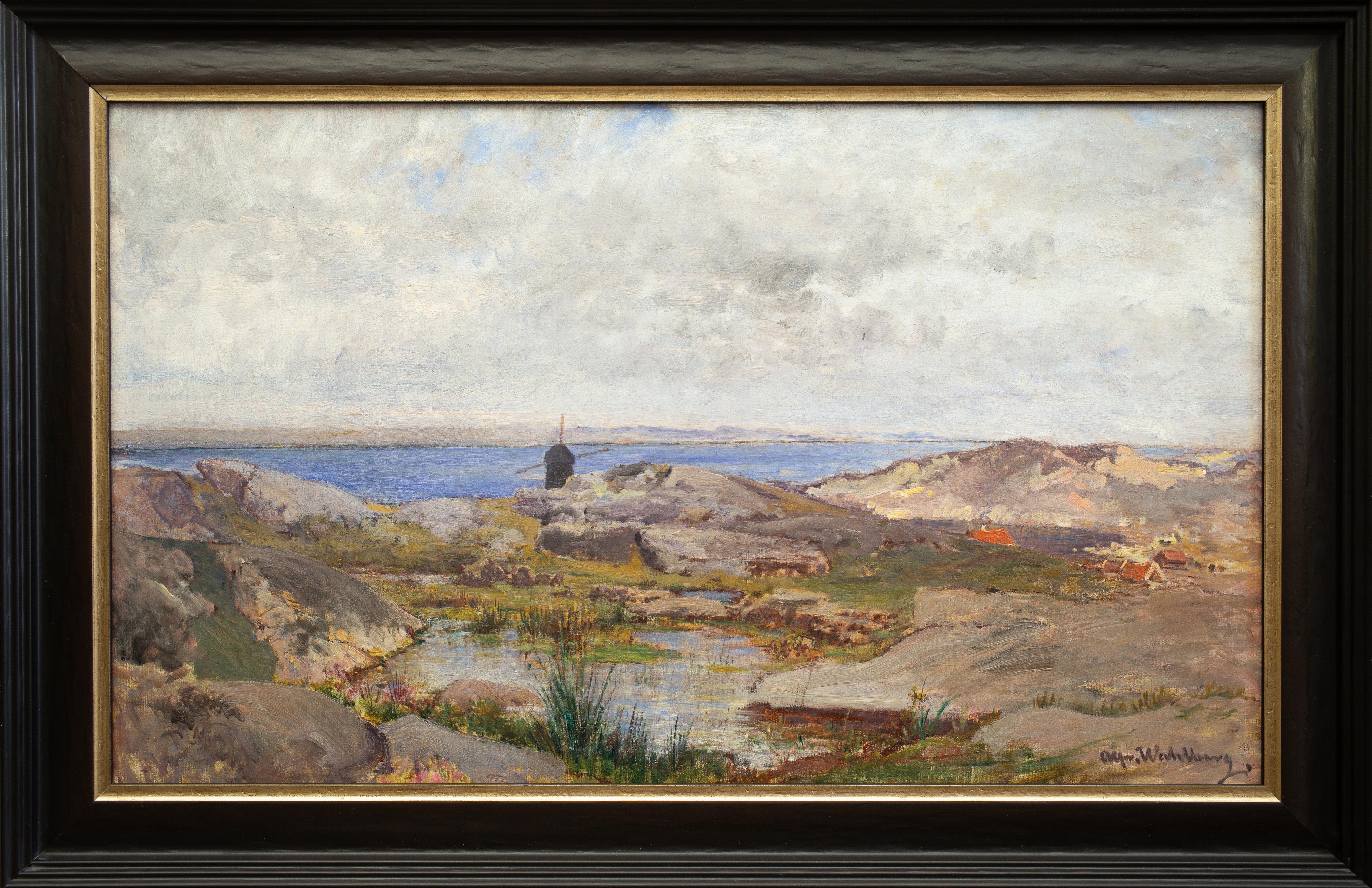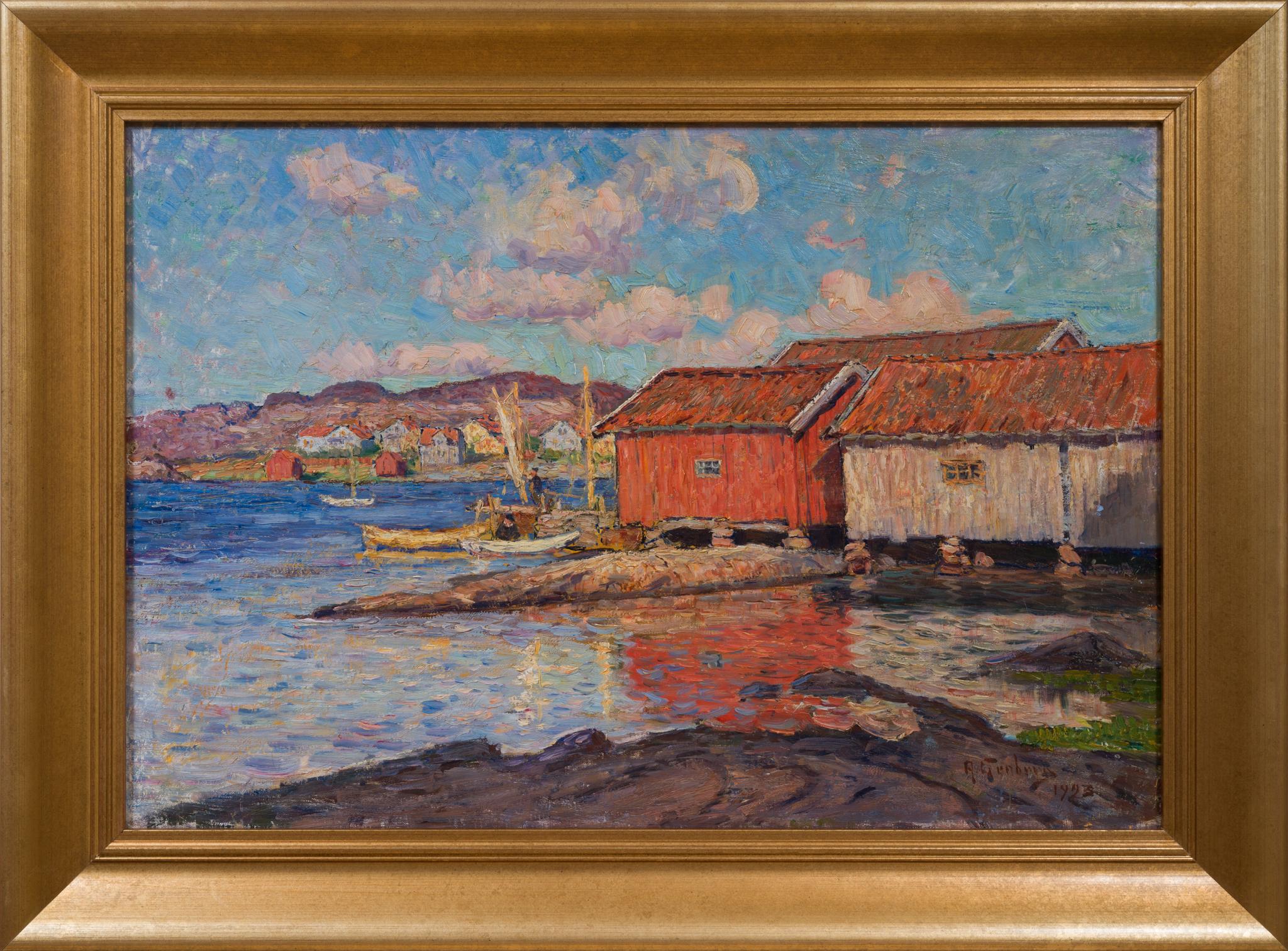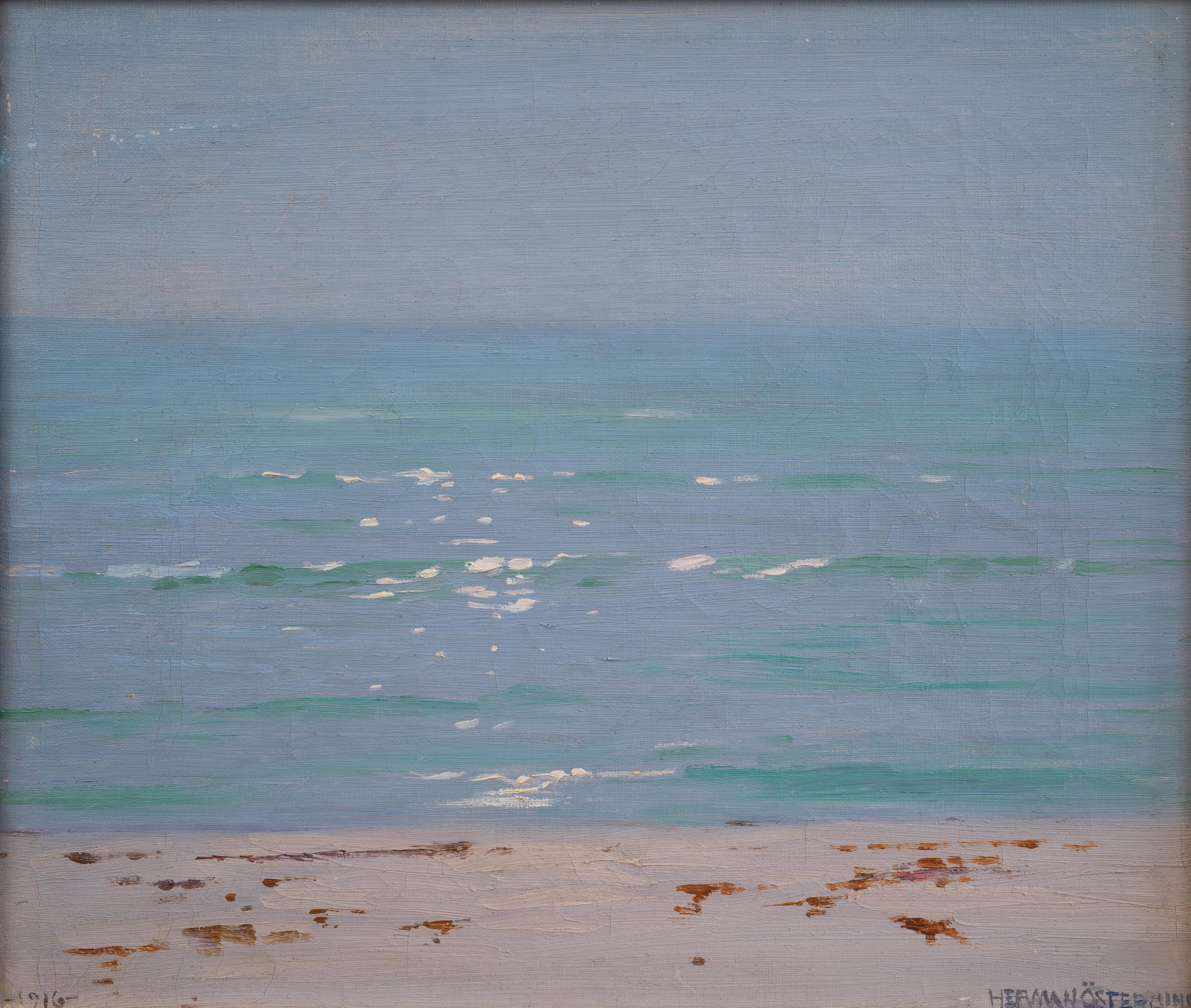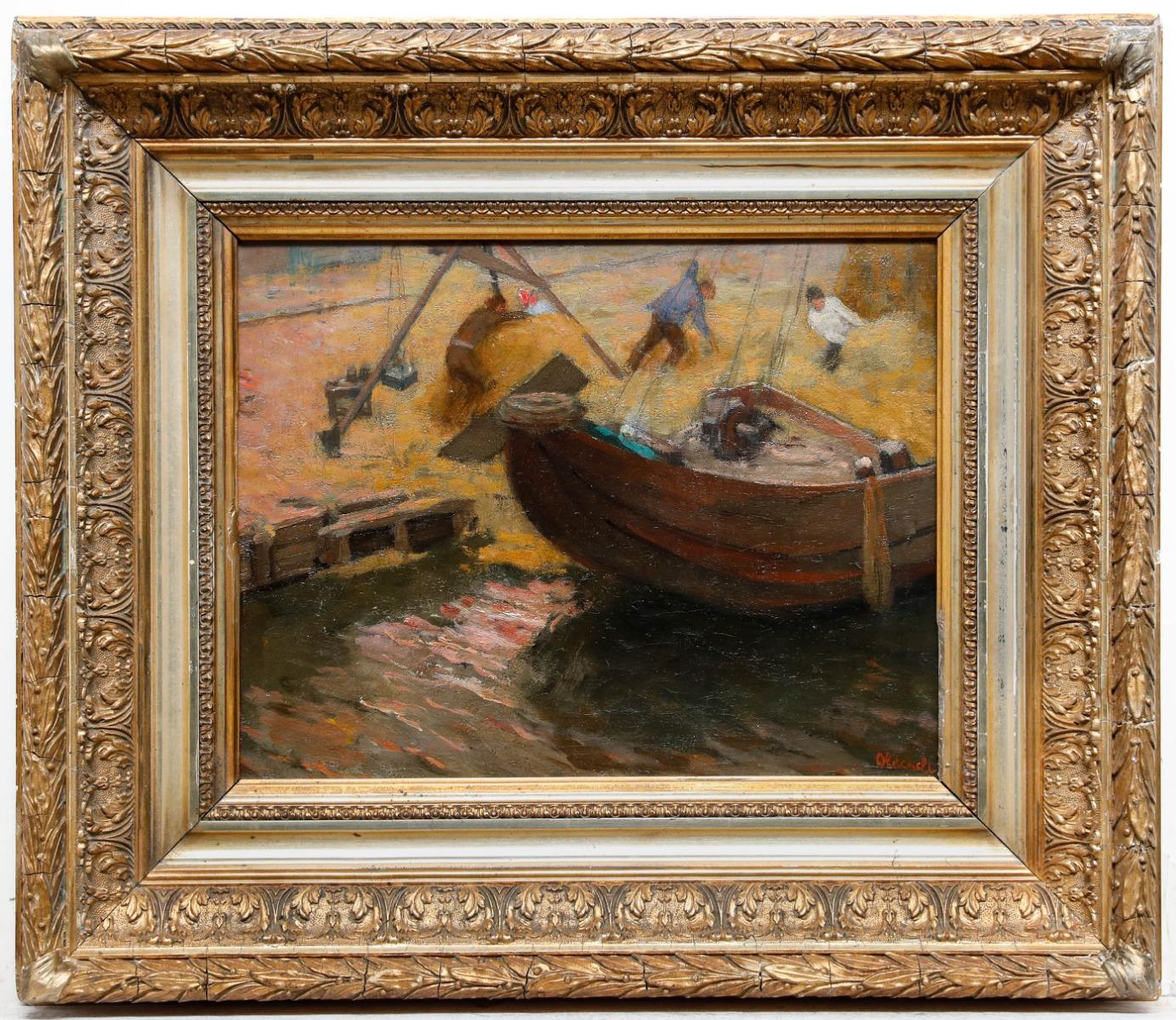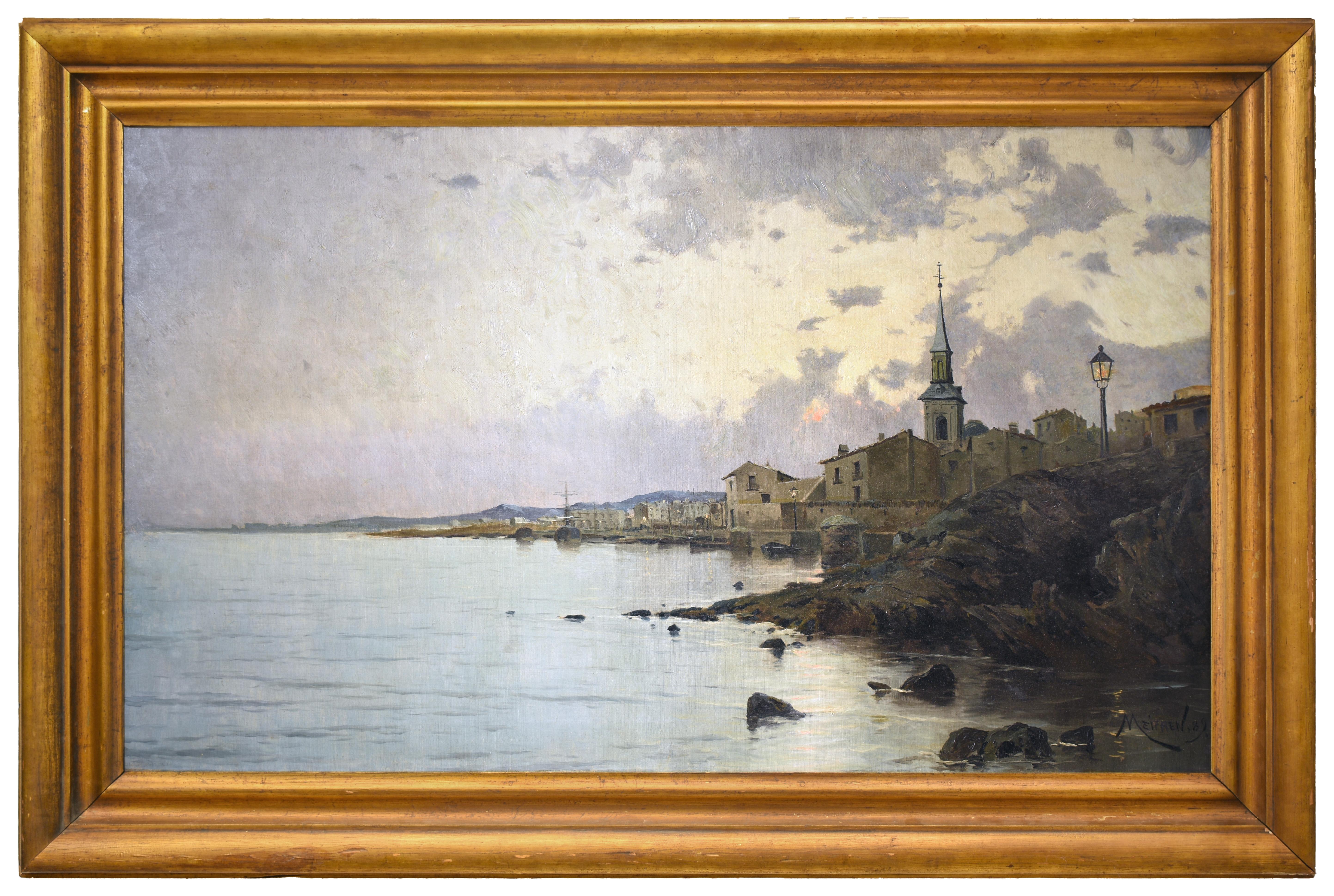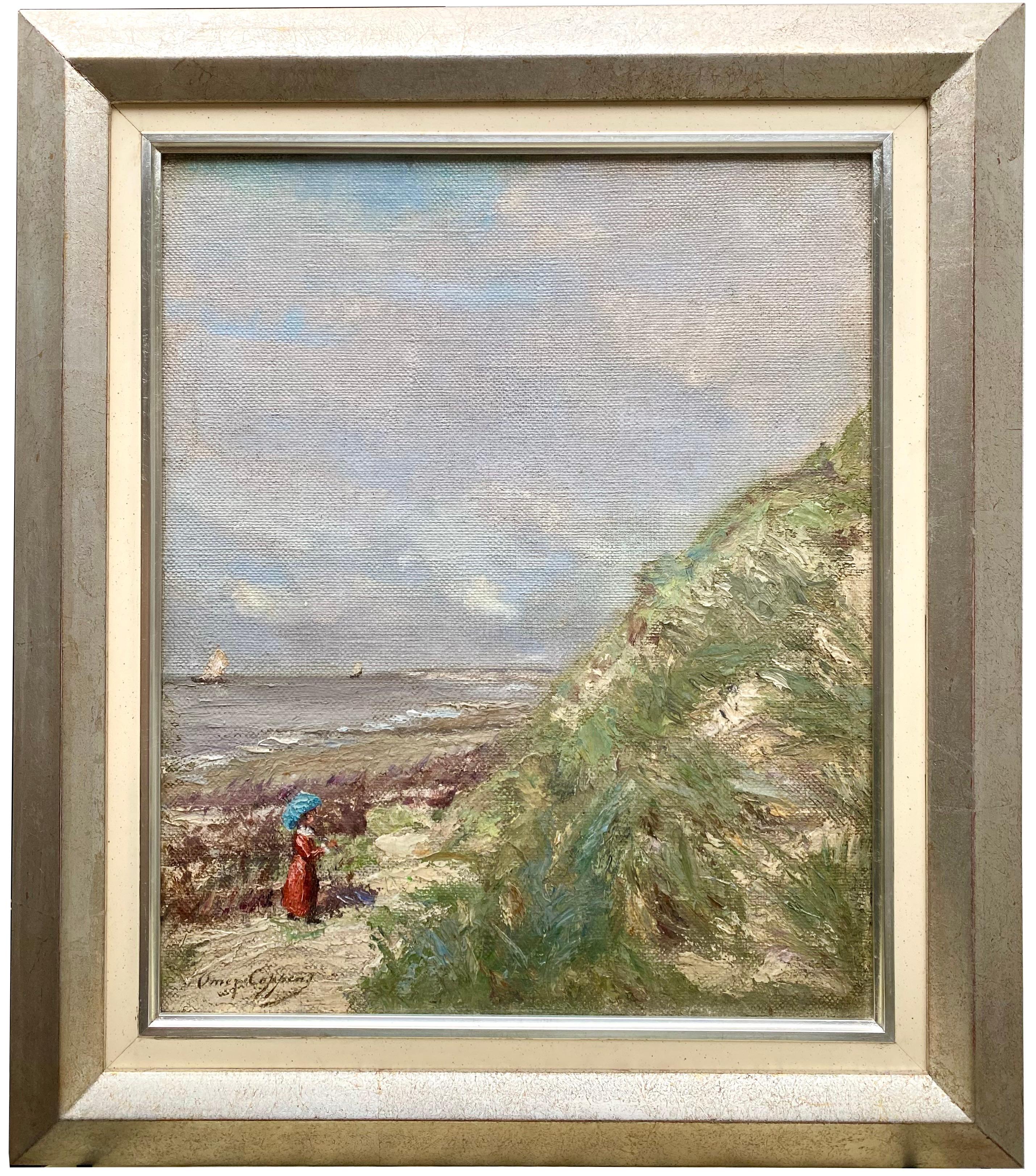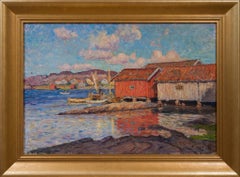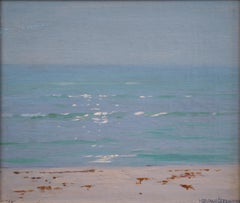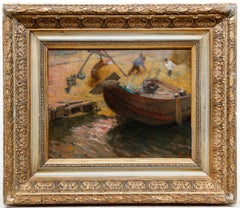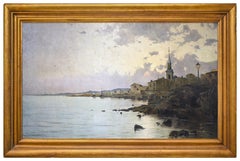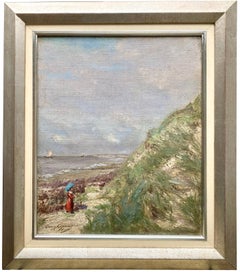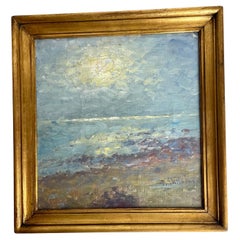Items Similar to Afternoon Mood – Wallén’s Skagen-like Swedish Coastal Masterpiece
Video Loading
Want more images or videos?
Request additional images or videos from the seller
1 of 17
Gustaf Theodor WallénAfternoon Mood – Wallén’s Skagen-like Swedish Coastal Masterpiece1886-1887
1886-1887
$139,000
£105,397.69
€120,927
CA$197,779.98
A$214,546.60
CHF 112,820.58
MX$2,610,598.40
NOK 1,410,439.07
SEK 1,330,217.25
DKK 902,874.89
About the Item
Gustaf Theodor Wallén (1860–1948) Swedish
Afternoon Mood, c. 1886-1887
oil on canvas
signed G.T.Wallén
unframed 100 x 150 cm (39 ⅜ x 59 in)
framed 130 x 180 cm (51 ⅛ x 70 ⅞ in)
Provenance:
By descent within the family until 2025.
Literature:
Urban Windahl: Gustaf Theodor Wallén, Stiftelsen Walléngården, 1992, cf. similar motif Afternoon Mood, Vitemölla, Skåne, 1886–87, illustrated p. 21.
ESSAY:
Early Training and Artistic Development
Gustaf Theodor Wallén was part of a generation of Swedish artists who came of age in the late 19th century amid a shift toward realism and plein-air painting. Born in Stockholm, he first trained in crafts and drawing before enrolling at the Royal Academy of Fine Arts in 1879. At the Academy’s antique school he studied alongside noted peers such as Bruno Liljefors, Anders Zorn, Carin Bergöö (later Larsson), and Jenny Nyström. Under the academic tutelage of Professor Georg von Rosen, Wallén developed strong foundational skills in drawing and composition. His early works during the 1880s still reflect academic genre themes and careful technique, but he, like many of his contemporaries, soon became captivated by painting directly from nature. This period in Scandinavian art – often termed the Modern Breakthrough – saw young artists turn from idealized subjects to scenes of everyday life and truthful depictions of nature. Wallén’s formative years thus positioned him at the crossroads of academic tradition and emerging plein-air naturalism, preparing him for the stylistic evolution to come.
“Afternoon Mood” at Vitemölla – Coastal Realism and Nordic Light
Wallén’s breakthrough came with a coastal scene from southern Sweden that marries academic skill with fresh naturalism. Around 1886–87 he painted Eftermiddagsstämning, Vitemölle, Skåne (“Afternoon Mood, Vitemölla, Skåne”), also known as I väntan på far (“Waiting for Father”). The motif was drawn from the fishing village of Vitemölla on Skåne’s Österlen coast. In the composition, a solitary fisherman's boy stands on the sun-warmed shore in the late day, gazing intently toward the horizon. The atmosphere is tranquil; a few fishing boats have been pulled onto the sand and nets hang to dry, suggesting the day’s work is done. Wallén suffuses the scene in a golden, gentle light – “a warm afternoon light” with “a Skagen-like shimmer” settled over the calm sea. This luminous treatment of sky and water is reminiscent of the famed Skagen painters just across the strait in Denmark, who were celebrated for capturing the translucent coastal light that merges sea and sky. Indeed, contemporaries such as P.S. Krøyer in Skagen were similarly enchanted by the unique Nordic light and painted en plein air to record its effects, producing realist portrayals of intense light over sand and sea. Like those artists, Wallén conveys a precise time of day and mood through light: here the soft glow of afternoon evokes a peaceful expectancy as the boy awaits his father’s return.
Despite these parallels, Wallén’s Afternoon Mood also reflects his own artistic sensibility. In contrast to some Skagen works that bustle with communal life or dramatic action, Wallén’s scene is quietly contemplative. The child’s lone figure and the expansive horizon create an almost poetic silence, differing from the convivial social scenes Krøyer often painted or the heroic rescue dramas of Michael Ancher. Yet the shared spirit is evident – a commitment to realist open-air painting and the study of natural light, hallmarks of the Scandinavian plein-air movement. Wallén’s careful draftsmanship (honed at the Academy) combines with an atmospheric sensitivity to result in a painting both realistic and emotive. Titled “Afternoon Mood” for exhibition, the composition was awarded the Royal Medal by the Royal Swedish Academy in 1887. This high honor not only marked Wallén’s emergence among Sweden’s notable painters, but also qualified him for a prestigious state travel scholarship. Wallén is known to have painted several versions of this motif, and while it is difficult to say with certainty which version was exhibited and received the medal, the present work clearly belongs to that important group. In essence, Afternoon Mood at Vitemölla stands as an early masterpiece of Wallén’s, capturing the Nordic coastal light with a skill that aligns him with his Danish Skagen counterparts while maintaining a distinctively Swedish narrative tenderness.
Paris, Travel, and Evolving Style
Winning the 1887 Royal Medal proved transformative for Wallén’s career. Along with the honor came a three-year state stipend to study abroad – a generous grant that secured his livelihood and allowed him to engage directly with Europe’s art centers. In 1888 he departed for Paris, then the mecca of avant-garde art. There he briefly trained under the academic master William Bouguereau at the Académie Julian and later at the more progressive Académie Colarossi. Immersed in Paris’s lively art scene, Wallén exhibited at the Salon and absorbed contemporary currents ranging from Academic classicism to Impressionism. He often sketched along the quays of the Seine amid the urban bustle, though true plein air painting proved challenging in the city’s chaos. Seeking subjects more akin to his coastal Swedish roots, Wallén spent summers in the artists’ colony at Concarneau in Brittany (1889) and later on the island of Capri in Italy. In Brittany’s Finistère region – much like Skagen – he found his beloved motifs of boats, harbors and seaside life; paintings from these years are dominated by marine and coastal subjects. Works such as “Growing Pumpkins in Brittany” indicate his interest in rural coastal communities, paralleling the naturalist trends of the time. On Capri and during travels through Italy and Spain, Wallén also encountered Mediterranean light and color, further enriching his palette and subject matter.
Wallén’s stylistic evolution during this period is marked by a blend of his solid academic technique with the looser brushwork and truthful lighting of plein-air realism. A major achievement of these travels was his canvas I sorgehuset(“In the House of Mourning”), painted 1889–90, which depicted a moving genre scene likely inspired by his observations abroad. Shown at the Paris Salon of 1892, I sorgehuset earned Wallén a Salon medal and was even purchased by the French state – an exceptional honor for a Swedish artist of the day. This international recognition underscored how far Wallén’s art had come: from Stockholm’s academic halls to standing alongside Europe’s finest. Critics praised the work’s emotive realism, evidence that Wallén had successfully integrated modern naturalist sensibilities into his painting. By the early 1890s, he was exhibiting both in France and back home, and from 1894 he became a regular exhibitor with the progressive Swedish Artists’ Association (Konstnärsförbundet). In these mature years, Wallén’s oeuvre ranged from landscapes and seascapes to intimate portraits and genre scenes, in oil and watercolor, and even sculptures – reflecting a versatile artistic curiosity.
Wallén and the Skagen Painters: Similarities and Differences
Wallén’s art occupies a fascinating place within the broader Nordic artistic milieu of the late 19th century. Like his Danish and Norwegian contemporaries in the Skagen artists’ colony, he was drawn to authentic depictions of coastal life and the fleeting effects of light. The Skagen painters – P.S. Krøyer, Anna and Michael Ancher, Oscar Björck (a fellow Swede), among others – gathered in the 1880s to paint the fishermen, beaches and distinctive “intense light on the narrow sand spit” at Denmark’s northern tip. They practiced realist plein air painting, sitting in the dunes to capture sunsets, shimmering surf, and the everyday labor of the local folk. Wallén’s Afternoon Mood at Vitemölla clearly springs from the same impulse to portray a humble fishing community with honesty and atmosphere. The “Skagen-like shimmer” noted in his Vitemölla scene was no coincidence – artists across Scandinavia were enthralled by the unique quality of Nordic coastal light, whether on Skagen’s shores or Sweden’s Skåne coast. In both Skagen and Vitemölla, the sea’s reflective expanse and low northern sun produced a silvery luminosity that artists endeavored to record on canvas. Wallén’s treatment of hazy sunshine over calm waters, and his focus on a local child by the shore, echo the Skagen school’s mix of naturalism and poetic mood.
There are, however, illuminating differences in emphasis. Peder Severin Krøyer, for instance, became famous for his depictions of the “blue hour” twilight on Skagen’s beach – works like Summer Evening at Skagen – using loose brushstrokes and an almost impressionistic touch to capture that evanescent blue light. Wallén’s light in Afternoon Moodis the warmer glow of late afternoon, painted with a somewhat tighter, more blended technique befitting his academic background. Where Krøyer and others often populated their scenes with multiple figures – fishermen gathering nets, artists at dinner, or elegant friends strolling by the sea – Wallén’s composition centers on a single small figure, creating an intimate narrative of anticipation. This restraint gives Wallén’s work a contemplative solitude, closer in spirit to certain quiet Skagen scenes (such as Anna Ancher’s solitary interiors or Viggo Johansen’s hushed family moments) than to the group tableaux of Krøyer. In subject matter, Wallén was painting his own Swedish coast and its people, but he shared the Skagen artists’ ethnographic respect for local traditions and their modern, unidealized view of rural working folk. Technically, both Wallén and the Skagen painters painted from life in the open air, often starting studies on the spot – Krøyer’s canvases famously contained grains of sand from painting on the beach – but Wallén, ever the meticulous draftsman, would ensure a polished finish suitable for Salon and Academy exhibitions. In sum, Wallén can be seen as part of this broader Scandinavian movement that wedded French-influenced plein-air realism to Nordic subjects. His work stands alongside the Skagen painters’ as a regional variant: equally enthralled by light and life by the sea, yet filtered through his own Swedish lens and personal temperament.
Later Career and Legacy in the Nordic Context
By the turn of the 20th century, Wallén had established himself as a respected artist and even expanded into printmaking and sculpture. Around 1900 he chose to settle in the village of Leksand in Dalarna, central Sweden – a region rich with folk culture and idyllic landscapes. There he joined a circle of artists led by Gustaf Ankarcrona, becoming part of a local artists’ colony that arose under the era’s burgeoning national romanticism. Alongside painters like Emerik Stenberg, Anselm Schultzberg and others, Wallén turned his attention to scenes of Swedish rural life, folk costumes, and historical nostalgia that the national romantic movement celebrated. His painting Kulla i Kackaluva (a Dalarna folk girl) from 1902 is one such example of integrating regional folk themes into fine art. This phase highlights Wallén’s adaptability – from coastal realism in the 1880s to patriotic regionalism in the early 1900s – and underscores his role in the broader Nordic art narrative, where many late-19th-century artists later embraced their national heritage in subject and style.
Notably, Wallén’s output slowed after about 1920. Ever the multifaceted craftsman, he devoted much of his energy to building his own residence and studio at Leksand (completed in 1917) in a traditional timber national-romantic style. He was also a generous mentor and patron of the arts in his community, eventually donating his home and a collection of his works to establish a folk high school for crafts and drawing in Leksand. Wallén remained somewhat reclusive and reportedly reluctant to sell his paintings during his life, which meant that his art was seldom seen on the open market for decades. It was only in December 1947 – at the age of 87 – that he held his first major solo exhibition, in Gothenburg, showcasing a lifetime of work to great acclaim. He passed away shortly thereafter in January 1948, just weeks after witnessing a late but enthusiastic recognition of his artistry.
Today, Gustaf Theodor Wallén is remembered as a talented yet understated figure of Nordic art. His paintings can be found in Swedish museums such as the Nationalmuseum in Stockholm and the Dalarnas Museum, as well as in the collection of Wallénhallen in Leksand – a cultural center honoring his legacy. For contemporary viewers and collectors, Wallén’s work offers a richly informative window into the Nordic artistic milieu of the late 19th century. His early canvas of Vitemölla, with its golden light and quietly narrative realism, stands as a Swedish counterpart to the Skagen masterworks of the same era, equally worthy of appreciation. In Wallén’s oeuvre, one finds the confluence of academic skill, plein-air innovation, and deep regional affection – a combination that not only enriches any gallery presentation of his 1880s seaside scene, but also illuminates the broader story of Scandinavian art’s flourishing at the dawn of modernity.
Condition Report
Recently examined and treated by a professional art conservator in Stockholm, the painting has undergone careful restoration. The old, yellowed varnish was replaced with a fresh, clear layer, and a few discreet retouchings were made. The colors now appear vivid and luminous, restoring the work to its original brilliance. As is typical for paintings of this age, there are fine, stable craquelures. A few faint pressure marks from the stretcher are visible in the central area, though these are very minor. Overall, the work is in excellent condition. The original frame is included and retains a few small repairs.
Sources
Urban Windahl: Gustaf Theodor Wallén – Skåne, Concarneau, Capri, Stockholm, Leksand, Stiftelsen Walléngården, 1993.
Wallénhallen Foundation archives, Leksand.
Auction catalogues, including Bukowskis, for biographical and artwork-specific details.
Hirschsprung Collection, Copenhagen – materials on the Skagen painters and plein-air practice.
Nationalmuseum, Stockholm – collection notes on Wallén’s works.
General art historical context from Scandinavian art monographs and museum publications on Nordic light and late-19th-century plein-air movements.
- Creator:Gustaf Theodor Wallén (1860 - 1948, Swedish)
- Creation Year:1886-1887
- Dimensions:Height: 51.19 in (130 cm)Width: 70.87 in (180 cm)
- Medium:
- Movement & Style:
- Period:
- Condition:Professionally restored 2025 with old varnish replaced and minor retouching. Colors are vivid, with fine, stable craquelures typical of its age. Minor stretcher marks visible in some light. Excellent overall condition. Frame with minor flaws.
- Gallery Location:Stockholm, SE
- Reference Number:1stDibs: LU1445216789962
About the Seller
5.0
Platinum Seller
Premium sellers with a 4.7+ rating and 24-hour response times
Established in 2020
1stDibs seller since 2020
200 sales on 1stDibs
Typical response time: <1 hour
Associations
International Confederation of Art and Antique Dealers' Associations
- ShippingRetrieving quote...Shipping from: Stockholm, Sweden
- Return Policy
Authenticity Guarantee
In the unlikely event there’s an issue with an item’s authenticity, contact us within 1 year for a full refund. DetailsMoney-Back Guarantee
If your item is not as described, is damaged in transit, or does not arrive, contact us within 7 days for a full refund. Details24-Hour Cancellation
You have a 24-hour grace period in which to reconsider your purchase, with no questions asked.Vetted Professional Sellers
Our world-class sellers must adhere to strict standards for service and quality, maintaining the integrity of our listings.Price-Match Guarantee
If you find that a seller listed the same item for a lower price elsewhere, we’ll match it.Trusted Global Delivery
Our best-in-class carrier network provides specialized shipping options worldwide, including custom delivery.More From This Seller
View AllSummer Day on the West Coast of Sweden by Swedish Impressionist Alfred Wahlberg
Located in Stockholm, SE
Alfred Wahlberg was a distinguished Swedish landscape painter whose career spanned Germany, France, and Sweden. During his early years, he resided in D...
Category
Late 19th Century Impressionist Landscape Paintings
Materials
Canvas, Oil
$2,681 Sale Price
20% Off
Free Shipping
Coastal Scene from the Swedish West Coast (1923)
Located in Stockholm, SE
Anton Genberg’s coastal painting captures a tranquil harbor scene along Sweden’s west coast. In this 1923 oil painting, a cluster of weathered boathouses stands by the water’s edge, ...
Category
1920s Impressionist Landscape Paintings
Materials
Canvas, Oil
Ocean View from the West Coast by Swedish Artist Herman Österlund, 1916
Located in Stockholm, SE
Herman Österlund (1873-1964) Sweden
Ocean View from the West Coast, 1916
oil on canvas
signed and dated Herman Österlund 1916
canvas dimensions 14.37 x 16.73 inches (36.5 x 42.5 cm...
Category
1910s Naturalistic Landscape Paintings
Materials
Canvas, Oil
Impressionist Lake Motif From Sturehäll, Stockholm, 1892
Located in Stockholm, SE
This painting called Sturehäll by Carl Johansson, crafted in 1892 when the artist was 29 years old, offers a captivating glimpse of Sturehäll, near Sturehov in Norsborg. This piece, ...
Category
1890s Impressionist Landscape Paintings
Materials
Canvas, Oil
$4,592 Sale Price
20% Off
Halmstad Harbour Seen From the North, 1889
Located in Stockholm, SE
The painting "Halmstad Harbour Seen From the North" by Oscar Ohlson is a captivating snapshot of daily life and historical architecture, frozen in time from the year 1889. With a meticulous eye for detail, Ohlson has rendered approximately 25 boats in the harbor, each brimming with the quiet bustle of daily chores. The painting invites viewers to step into a moment where people converse, work, and seek respite from the sun under shared umbrellas, while wisps of smoke subtly rise from several boats, suggesting the presence of life and activity beyond the canvas.
In this vibrant scene, a man carries a sack, perhaps fresh merchandise from one of the docked vessels, while others engage in conversation, highlighting the social tapestry of the harbor. Ohlson's masterful use of light reflects on the water, creating a shimmering path that leads the eye to the majestic Halmstad Castle, which adorns the right side of the painting. This historic building, beautifully situated by the Nissan river and not far from the sea, is a testament to Halmstad's past as a Danish territory. Constructed in the early 17th century during the reign of King Christian IV, the castle stands as a reminder of the town's rich history and cultural heritage.
The first building to the right, once part of this historic tableau, has been removed to accommodate modern necessities, replaced by a road that now runs through its former site. This juxtaposition of past and present is a poignant commentary on the evolution of cities and the sacrifices made in the name of progress.
Halmstad itself, a town that straddles the Nissan river, retains much of its early 20th-century character in its city core. Low brick and half-timbered houses, some dating back to the 17th century, dot the landscape. The town center on the west side of Nissan is bordered by remnants of early 17th-century fortifications, including the 1600s castle, Norre Port from 1601, and King Charles XI's path along the old fortress wall. At the heart of the town is Stora Torg with Carl Milles' Europa and the Bull fountain from 1926, and the town hall built in 1938. The city layout, influenced by Renaissance planning, converges at Stora Torg, which is also home to the town's sole medieval building, the brick hall church of St. Nikolai from the 14th century.
Oscar Ohlson (1847-1912), a native of Linneryd, Småland, was a multifaceted individual. Beginning his career with a legal degree from Uppsala University in 1870, Ohlson's passion for the arts led him to pursue music studies before dedicating himself to art under the guidance of Alfred Wahlberg...
Category
1880s Realist Landscape Paintings
Materials
Canvas, Oil
Lakeside at Gärdsvik, Ljusterö, 1891
Located in Stockholm, SE
In the soft evening light, a lone figure rows a small boat across the calm water, while tall reeds fringe the quiet shoreline in the foreground. Rolling wooded hills embrace the lake...
Category
1890s Impressionist Landscape Paintings
Materials
Canvas, Oil
You May Also Like
Ferdinand Gustaaf Oldewelt (1857-1935) - Framed Oil, Hayship Harbour
By Ferdinand Gustaaf Oldewelt
Located in Corsham, GB
This Impressionist oil painting depicts a Dutch harbour scene (probably Rotterdam) with workers unloading a ship with hay. The artist employs loose, impressionistic brushwork to conv...
Category
Mid-20th Century Figurative Paintings
Materials
Oil
Coastal scene
Located in New York, NY
Fue miembro del grupo pictórico de Sitges. En 1888 formó parte del jurado de la Exposición Universal de Barcelona. Comenzó su formación en la Escuela de Bellas Artes de Barcelona, do...
Category
Late 19th Century Impressionist Landscape Paintings
Materials
Canvas, Oil
'By the Sea' by Omer Coppens (Dunkirk 1864 – 1926 Ixelles) French-Belgian
By Omer Coppens
Located in Knokke, BE
Omer Coppens
Dunkirk 1864 – 1926 Ixelles
French-Belgian Painter
'By the Sea'
Signature: signed lower left 'Omer Coppens'
Medium: oil on canvas
Dimensions: image size 46,5 x 39 cm,...
Category
Early 20th Century Impressionist Landscape Paintings
Materials
Canvas, Oil
Beautiful painting by the famous Swedish artist Per Ekström (1844-1935)
Located in Knivsta, SE
Beautiful painting by the famous Swedish artist Per Ekström (1844-1935). He studied at the Academy of fine arts from 1865-1872
He worked in Paris, Barbizon and Saint Germain from 18...
Category
Antique Late 19th Century Swedish Paintings
Materials
Canvas, Paint
French Coastal Sunset, possibly near Etretat, Le Havre, dated 1928
Located in Blackwater, GB
French Coastal Sunset, possibly near Etretat, Le Havre, dated 1928
by Alfred Bergström (1869-1930)
Fine huge 1928 French Coastal Sunset Landscape, p...
Category
19th Century Portrait Paintings
Materials
Canvas, Oil
$4,939 Sale Price
20% Off
L. Colborn - Early 20th Century Oil, End Of The Fishing Day
Located in Corsham, GB
This serene coastal scene depicts a group of fishing boats resting on a sandy shore, their masts reaching skyward against a pale blue horizon. Signed faintly to the lower right. Pres...
Category
20th Century Figurative Paintings
Materials
Oil
